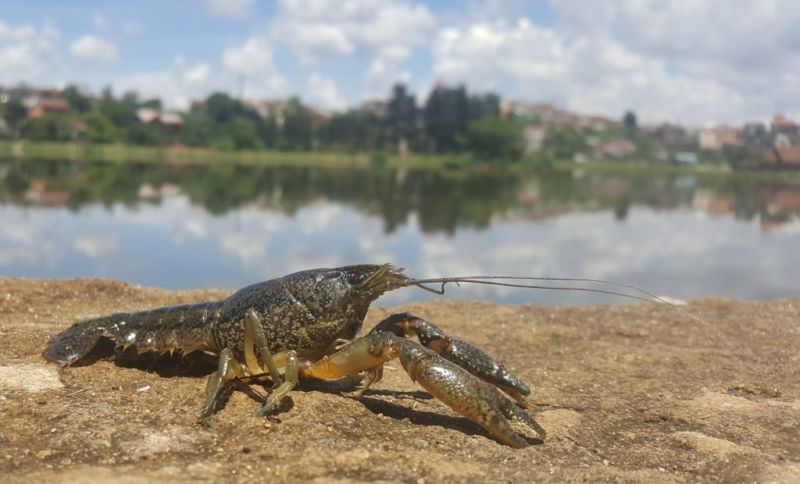Mutant crayfish got rid of males, and its clones are taking over the world

From a stream in Florida to a pet shop in Germany and on to Japan and Madagascar.
It's possible to infer many species' origins from things like fossils and DNA sequences. But for one creature, we have a specific date: 1995. That's when the first marbled crayfish appeared in a pet shop in Germany, mixed in with similar-looking animals that had originally come from streams in the US South.
When it came to selling pets, the marbled crayfish had a big advantage over its relatives: it doesn't need males to reproduce. Instead, females are able to produce genetic copies of themselves, allowing any fish tank to become a factory for an army of crayfish clones. Now, researchers have confirmed that these clones have spread throughout Europe, gotten as far as Japan, and begun invading the streams of Madagascar.
 Ranja Andriantsoa
Ranja Andriantsoa
Ostensibly, the publication that describes these results is about the completion of the genome for the marbled crayfish. And the genome is what has allowed researchers to confirm that crayfish from around the world are essentially clones. But the real story in Nature Ecology and Evolution is the evolution and global spread of an entirely new species in less than 25 years.
Pet shop girls
We know it's less than 25 years because the species originated in a German pet shop. The shop had been selling a species (Procambarus fallax) that originated in the streams of Georgia and Florida, when a different-looking crayfish appeared in their midst. Named "marmorkrebs," or the marbled crayfish, it had a feature that made it especially appealing for the pet trade: it was parthenogenic, meaning that it was an all-female species that produces viable eggs. Put one in a tank and it would eventually fill up with offspring that could all be sold as pets.
As we've seen in far too many cases, however, pets often end up reintroduced to the wild. And for marmorkrebs, the same feature that made it good for pet stores meant that a single escaped or abandoned crayfish could eventually populate an entire stream. marmorkrebs has now been found from Sweden to Italy and from the Netherlands to Ukraine. It's established itself in Japan and Madagascar, and it's been introduced back into the US as a pet, which means it's a matter of time until it ends up back in the wild here, too.
How does parthenogenesis work, and how can it produce a brand new species? Normally, when animals make eggs and sperm, they get rid of one of their two sets of chromosomes. That way, when egg and sperm combine, they re-establish the normal collection of two sets of chromosomes. In parthenogenic animals, the females never get rid of one of the sets of chromosomes. The eggs end up with two sets, both from their mother—from a genetic standpoint, they're clones of the mother.
In the case of marmorkrebs, its origin and the parthenogenesis seem to be related. The species seems to have three sets of chromosomes instead of the usual two. This could come about if a female produced an egg with two sets of chromosomes and then had it fertilized by a male that added a third.
The new genome sequence confirms that this was the case, as marmorkrebs carries two sets of nearly identical chromosomes, along with a third that's more distantly related. (Since crayfish apparently have a lot of chromosomes to begin with, this means that these animals carry around 276 individual chromosomes). Having an extra copy of every gene is probably useful, too, as a lack of sexual reproduction makes it impossible for reproduction to remove damaged genes from the marmorkrebs genomes.
It's possible that the original failure to divide up chromosomes during egg production was genetic, so the offspring of this mating would be prone to doing so as well. But it's also possible that a process that evolved to divide two sets of chromosomes in half simply choked when faced with three sets of chromosomes. In either case, the female offspring of this mating started producing eggs that included all three sets of chromosomes and were capable of developing into viable adults. In essence, the organism evolved a way to clone itself.
Globalization
And marmorkrebs has been remarkably successful, as ecological studies suggest that its range in just one country (Madagascar) has expanded from 1,000 square kilometers to 100,000 in just a decade. While still closely related to its American cousins, marmorkrebs has picked up enough genetic changes to be distinct from them at the DNA level. Meanwhile, populations from around the world are nearly identical—the authors tested lab strains from the US and Germany, pet shop and wild samples from Germany, and a number of animals obtained from different areas in Madagascar. Put differently, the globe is now filled with imperfect clones of a pet shop accident.
Normally, success in a wide range of ecosystems relies on a fair bit of underlying genetic diversity, which enables traits that help organisms adapt to local peculiarities. But in this case, marmorkrebs seems to be managing it with minimal adaptation, despite invading environments as diverse as Madagascar and Sweden. There are interesting genes in the sequence obtained by the authors; for example, marmorkrebs has enzymes that can break down cellulose, which is the rugged polymer that makes up plant walls and gives wood its strength (most other animals rely on bacteria to digest this). But these genes seem to be shared by other crayfish.
This rapid spread may be a problem for ecologists that are trying to preserve native species, but it's fascinating for biology. To begin with, the populations around the globe will gradually adapt to their new environment, and the new genome provides a baseline that we can use to identify the genetic changes that enable this. In addition, we're only aware of a handful of non-microbial species that have managed to forgo sexual reproduction for a long time. We know what genetic changes have enabled those species to survive without sex, so we can watch to see if any of the same things evolve in these crayfish.
=============================
by John Timmer
There may be links in the Original Article that have not been reproduced here.
Tags
Who is online
50 visitors

They could be used to end world hunger
Evolution in action